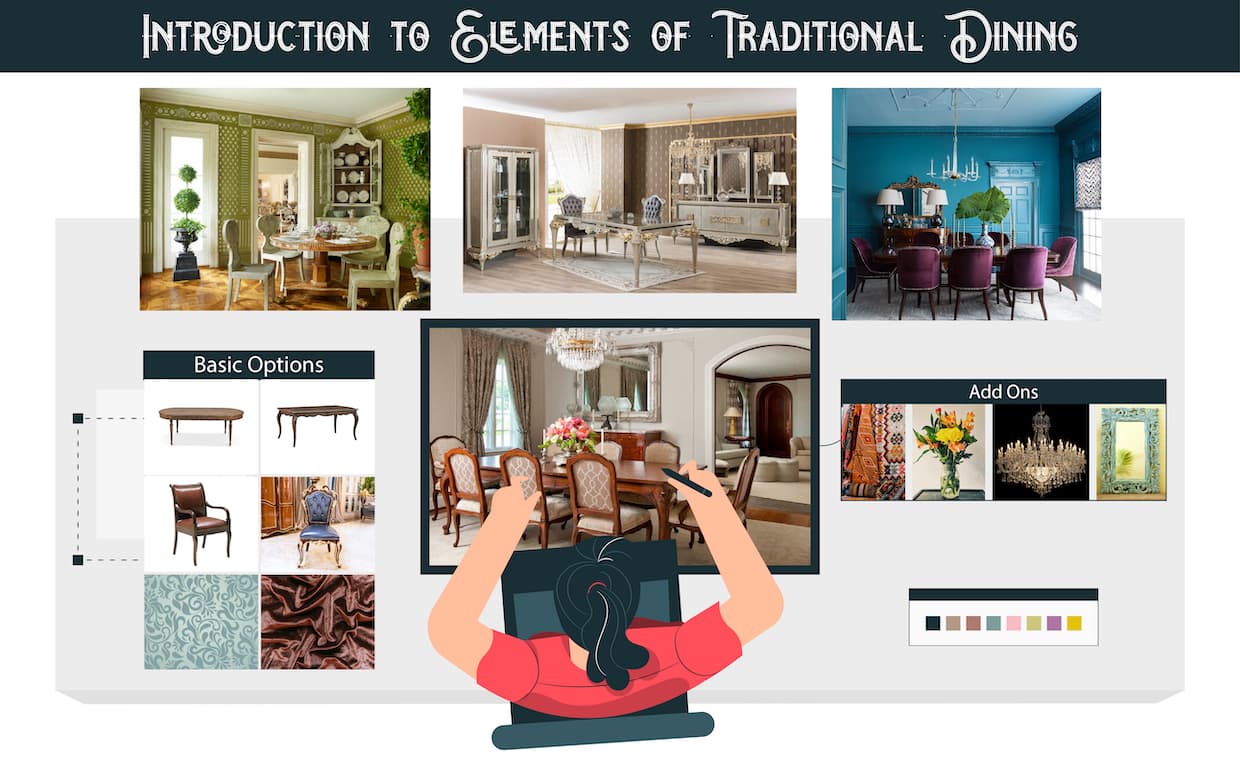
A stylish dining room amplifies the joy of good food, wine and company. However, a beautiful setting can elevate even the simplest meal into a special occasion. Such is the power of ambience! Through this blog, Gharpedia explores the style elements of traditional dining rooms and their evolution into contemporary dining room décor.
Witnessing the Transition of Traditional Dining Room

It wouldn’t be wrong to say that a dining room is a place where you can indulge in the luxuries of life. There was a time when meals used to be the focal point of family life. Even today, this room is used to more than just relish meals. It is also used for playtime and homework time for kids while the mother cooks dishes. Design professors Kilmer, R. & Kilmer, W. O[402] highlighted an intriguing transition from the conventional dining area to modern times in their book “Designing Interiors”. Houses had designated modern traditional dining rooms after the 1960s. In older homes, the kitchens were made more prominent by knocking down the internal wall. After that, the dining areas were made bigger by removing the wall between the dining and living areas, creating an open-plan space. It became a luxury because only people with large houses had them. Extensions of old spaces with contemporary elements of traditional dining updates paved the way for modern dining rooms.

There has been a natural progression towards reinstating the traditional dining room decor. It is a trend now to invite your guests into your traditional dining room to serve them a lovely meal without a television or kitchen sink in sight. An efficient kitchen feels nothing less than heaven. To ensure you have the same, check out these
Have you ever wondered what traditional dining room decor looks like? What are the elements of traditional dining that constitute the decor? Let’s have a closer look at things in dining room.
Elements of Traditional Dining

The traditional dining room style is timeless and beautiful, adding warmth to the room. The dining space has a sophisticated yet cosy vibe thanks to dark tones, curved lines, and other subtle finishing touches.
Even though the dining room is all about eating, its styling is not restricted to traditional dining chairs and tables but also incorporates flooring, lighting and colour. In “The House Book”, editor ‘Fiona B[386]‘ analyses the various items in the dining room from the above-mentioned list assemble to form a potent mix of traditional dining elements. Before we jump into details to enhance the room’s ambience, it’s equally important to plan a perfect dining room. Now let’s probe a little deeper to see what it reveals.
01. Traditional Dining Table

Features of classic dining table designs are their rectangular shape, dark wood finish, curved legs, and intricately carved details. Traditional dining tables are usually expensive and are one of the few pieces of furniture that hold their value, whether in fashion or not.
Finding The Perfect Traditional Dining Table For your Home

Choose a table that fits your space properly; it should have enough space around it for you to draw out the chairs and serve a meal without having to cling to the wall. Most traditional dining tables have hidden fold-out flaps that can be opened to increase seating from four or six to eight or ten. Along with table, chairs are usually present. These elements of traditional dining are ideal for occasional entertainment. A few other pieces of furniture needed in a dining room are a console table, sideboard or trolley for the food.
02. Traditional Dining Chair

The chairs are the essential components of a sophisticated dining area. Of course, you could always make a false table by covering an old door on trestles with a fancy tablecloth. However, since they will be on display, the chairs should be as attractive and comfortable as possible. Traditional dining room chairs have peculiar features, including soft edges, armrests, arching backs and luxurious upholstery.
Tips to Buy Chair The Right Way

The best part about going with the antique style is that you can always find used dining chairs at flea markets or auctions for a reasonable price. The idea is to purchase these elements of traditional dining individually, in groups of two, three, or more because doing so always results in significant savings. In addition, they don’t have to be identical as long as they are from the same era and have a similar aesthetic. In fact, a slightly mismatched collection of chairs can look chic if you decorate them similarly.
Revamping the Old Chairs

Wooden chair can be converted as elements of traditional dining just sitting at home. Wooden chairs with upholstery are revamped with a fresh coat of paint and a change of fabric to create a traditional dining chair. Wooden chairs with upholstered seats can be given a new style with a change of fabric and paint. First, strip the wood of its old varnish, refinish it in a dark, rich brown, and then cover the seats with velvet or brocade fabric in a warm colour. Also, look for surplus or leftover pieces of good-quality upholstery fabric or old curtains; these are often abandoned when people move houses. Keeping the upholstery clean is daunting, but these upholstery cleaning tips will make it a cakewalk.
03. Traditional Dining Colours

Colours can add a rich, intense and dramatic effect to elements of traditional dining rooms. Along with the curtains and lighting, hang large-framed pictures and mirrors on the walls.
Adding the Classic Touch of Colours to Elements of Traditional Dining

Paint the woodwork with matte white or any other pale shade, which is integral to traditional dining room paint colours. Then, using glass paper, rub the paint back into the raw wood in some spots to give it a ‘mildly distressed’ appearance.
Finally, a red, yellow or blue gingham or stripe can be used to cover the seats. Check this DIY chair painting with a new cushion cover to refinish your old chair at home.
04. Stencilling

Try stencilling a border pattern on the floor instead of a carpet if the room is warm enough to cope without one. Stencilling, one of the drawing elements of traditional dining is an excellent way to get the unifying look of an expensive carpet at a fraction of the price. There are some fabulous stencil patterns available on the market. With a few pots of stencil paint and a dash of confidence, you could paint anything from a simple folk-art border to a convincing Turkish carpet in your spare time.
05. Lighting it up

If you own a chandelier, this is the place to use it. A candlelight dinner turns a simple dining experience into an occasion. The focal point of the dining room is a chandelier over the dining table.
“Keep looking for an old chandelier in a flea market – it will often need mending and rewiring, but it will be worth it,” quoted editor ‘Jeff D[84]’ in the book “Decorating 1-2-3”.
Adding the Finishing Touch to Elements of Traditional Dining

Finishing touches include traditional style matching cutlery, linen serviettes and fresh flowers. Don’t forget a smooth, white tablecloth with matching serviettes, traditional-style cutlery, sparkling glassware and a pretty vase of freshly cut flowers to complete the look. Just a couple of touches here and there, and you can give your dining room the traditional touch with these elements of traditional dining!
If you also want to add a country feel to your house, check out
Acing the English Country Decor Look!
Image Courtesy: Image 1(a), Image 1(b), Image 1(c), Image 1(d), Image 1(e), Image 1(f), Image 1(g), Image 1(h), Image 1(i), Image 1(j), Image 1(k), Image 2(a), Image 2(b), Image 3, Image 4(a), Image 4(b), Image 5(a), Image 5(b), Image 6(a), Image 6(b), Image 7(a), Image 7(b), Image 8, Image 9(a), Image 9(b), Image 10(a), Image 10(b), Image 11(a), Image 11(b), Image 12(a), Image 12(b), Image 13(a), Image 13(b), Image 14(a), Image 14(b)
Author Bio
Huta Raval – An English Literature and Journalism Topper, Huta Raval has graduated from the L D Arts College, Ahmedabad. Post serving for 23 years in the NBFC and Public Library Sectors her desire for ‘writing the unwritten’ brought her to the creative field of content writing. Her clientele comprises of NGOs, Blogging Platforms, Newspapers, Academic Institutions, et al.































